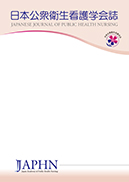Volume 6, Issue 3
Displaying 1-10 of 10 articles from this issue
- |<
- <
- 1
- >
- >|
Foreword
-
2017Volume 6Issue 3 Pages 239
Published: 2017
Released on J-STAGE: December 27, 2017
Download PDF (480K)
Research Article
-
Article type: Research Article
2017Volume 6Issue 3 Pages 240-248
Published: 2017
Released on J-STAGE: December 27, 2017
Download PDF (323K) Full view HTML -
Article type: Research Article
2017Volume 6Issue 3 Pages 249-257
Published: 2017
Released on J-STAGE: December 27, 2017
Download PDF (336K) Full view HTML -
Article type: Research Article
2017Volume 6Issue 3 Pages 258-267
Published: 2017
Released on J-STAGE: December 27, 2017
Download PDF (332K) Full view HTML -
Article type: Research Article
2017Volume 6Issue 3 Pages 268-277
Published: 2017
Released on J-STAGE: December 27, 2017
Download PDF (321K) Full view HTML
Public Health Nursing Report
-
Article type: Public Health Nursing Report
2017Volume 6Issue 3 Pages 278-287
Published: 2017
Released on J-STAGE: December 27, 2017
Download PDF (409K) Full view HTML -
Article type: Public Health Nursing Report
2017Volume 6Issue 3 Pages 288-296
Published: 2017
Released on J-STAGE: December 27, 2017
Download PDF (275K) Full view HTML
SERIES Challenge to Visualize the Grand Design of Public Health Nursing
-
2017Volume 6Issue 3 Pages 297-299
Published: 2017
Released on J-STAGE: January 17, 2020
Download PDF (1205K) -
2017Volume 6Issue 3 Pages 300-302
Published: 2017
Released on J-STAGE: January 17, 2020
Download PDF (924K)
-
2017Volume 6Issue 3 Pages 303-310
Published: 2017
Released on J-STAGE: January 17, 2020
Download PDF (1118K)
- |<
- <
- 1
- >
- >|
